The subjects of sentences can be simple or complex, as these activity sheets will demonstrate. Activities include identifying whether specified subjects are simple or complex, identifying both complex and simple subjects in a given sentence, unscrambling sentences to find the simple or complex subjects, converting simple subjects into complex subjects, and more. Answer sheets have been provided for worksheets for instructors, but please note that in some cases, your students' answers will vary. In many cases the simple and complete subject can be one in the same. We try to create sheets that don't have this happen often.
Printable Simple and Compound Subjects Worksheets
Click the buttons to print each worksheet and answer key.

Sometimes They Are The Same
Are the underlined word(s) a simple subject (SS) or a compound subject (CS)? Write your answer on the line.

So Simple
Underline the simple subject in each sentence. Use the examples to help your understand what is expected of you.

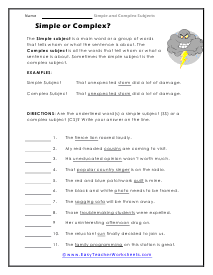
Simple or Compound?
Focus on the terms that are underlined and classify them. Write in the best answer that is provided with each sentence.
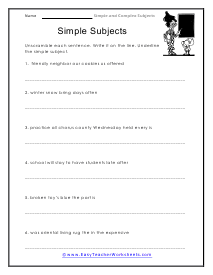
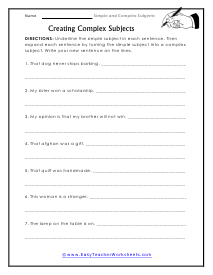
Transform Them
Underline the simple subject in each sentence. Then expand each sentence by turning the simple subject into a compound subject. Write your new sentence on the lines.
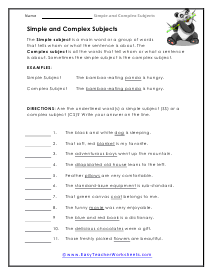
Simple and Compound Subjects
Identify the form of the subject present in each sentence. You will label each on the line that is provided
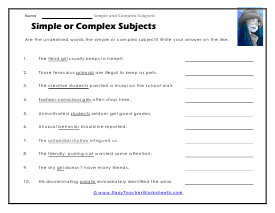
More Identification
Identify the purpose of each of the underlined terms. This one will give that extra practice that you may need..
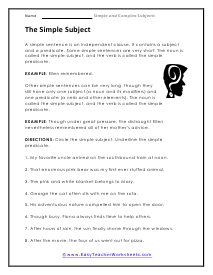
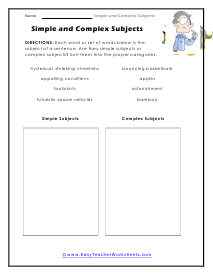
Sort Out The Subjects
Each word or set of words below is the subject of a sentence. Sort them into the proper categories. Take your time and read them a few times to make sure.
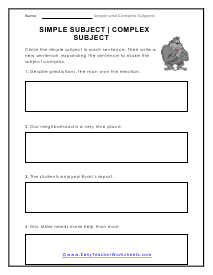
Expand That
Circle the simple subject in each sentence. Then write a new sentence, expanding the sentence to make the subject compound.
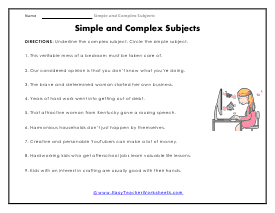
Underline and Then Circle
You will independently identify each of the subject types and clearly mark where they are present.
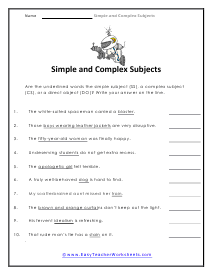
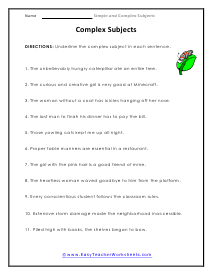
Compound Forms
Evaluate all the sentences and see where these terms of interest are located and then point them out to us.
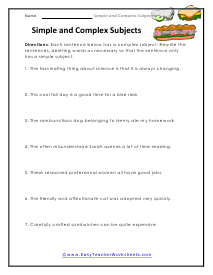
They Have Both
Each sentence below has a compound subject. Rewrite the sentences, deleting words as necessary so that the sentence only has a simple subject.

Picture Fills
Look at each picture. Write two sentences to describe it; one with a simple subject, and one with a complete subject.



Find the Basics
The Simple subject is a main word or a group of words that tells whom or what the sentence is about. The Complete subject is all the words that tell whom or what a sentence is about.

Unscrambles
Unscramble each sentence. Write it on the line. Underline what is asked of you at each step of the way.

Creating Them
Underline the simple subject in each sentence. Then expand each sentence by turning the simple subject into a complete subject. Write your new sentence on the lines.

What's Under That Line?
Are the underlined word(s) a simple subject (SS) or a complete subject (CS)? Write your answer on the line.

Take It To You
Are the underlined words the simple or complete subject? Write your answer on the line.


What's in My Backpack?
Classify what you see as you read all of these statements about your backpack.

Find It All
You will work off of the statement that you are given. you will classify parts of it and then you will rewrite the whole thing.

Get Under It!
You will diagnose the grammar that setup in all of these sentences and we'll see how you make out.

What's That?
We are classifying several parts of these sentence in this activity. Make sure to brush up by viewing each of the examples.


Delete That
Rewrite each of the sentences, deleting words as necessary so that the sentence makes sense and flows well based on what we have learned thus far.
What Are Simple and Compound Subjects In Sentences?
Lack of sentence variation is one of the most significant weaknesses in writing nowadays. If you've also been dealing with this problem, a proper understanding of the different types of sentences will help. To improve your comprehension of sentence types, you need to be more aware of the varying subjects within sentences.
To understand grammar and how to use it correctly in your writing, you must first learn about the different types.
It can be confusing to know the difference, but once you understand it, it's easy!We'll also provide some examples to help you practice. Understanding these concepts will help make your writing more concise and clear.
What is a Subject?
It is a person or thing doing the verb in a sentence. As far as a part of speech it usually presents itself as a noun or a pronoun. A simple sentence has one subject and one verb. The dog barks.
Most sentences have an explicit subject. The explicit form is the noun or pronoun that is doing the verb, for example:
The reporter interviewed the president. In this sentence, "The reporter" is the subject of "interviewed." "The president" is the object of "interviewed."
Sometimes the subject is not explicitly stated in the sentence, but it can still be understood from the context. In these cases, we can say that there is an implied or hidden form. For example:
In English, you use a lot of articles. ("You" is the hidden or implied subject of "use.")
What is a Complex Form?
When we think of subjects, the first thing that comes to mind is usually a noun—a person, place, or thing. However, it can also be a pronoun or even a group of words. In grammar, a complex or compound subject is one that consists of two or more nouns, pronouns, or other words that are joined together by a conjunction, such as and, or, or but.
For example, the sentence "The cat and the dog are sleeping" has a complex subject "The cat and the dog." In contrast, a compound form is one that consists of two or more independent clauses. For example, the sentence "John and Mary are going to the store" has a compound subject "John and Mary. Or, The big, black dog barked.
In this sentence, "The big, black dog" is a complex subject. It's made up of three words: "the," "big," and "black."
How to Find the Subject in a Sentence?
As we have been dicussing, it is usually found as a noun or pronoun. To find the subject, ask yourself who or what is doing the verb.
For example, let's take a look at the following sentence:
The dog barks. In this sentence, "The dog" is the subject. We know this because we can ask the question, "Who is barking?" The answer would be "The dog."
To find the subject of a sentence with an implied or hidden form, ask yourself who or what is doing the verb. For example, let's take a look at the following sentence: In English, you use a lot of articles.
In this sentence, "you" is the hidden subject. We know this because we can ask the question, "Who uses a lot of articles in English?" and the answer would be "You."
Lets dive deeper into this concept and see how it affects how write and produce written work.
Types of Sentences
Sentences are generally divided into four types. These include simple, compound, complex, and compound-complex sentences.
Simple Sentence
A sentence is considered simple if it offers a complete thought and includes a subject and a verb. "Independent clause" is another name for a simple sentence. Below are some examples of simple sentences.
- I am a chef.
(The subject is "I" while the verb is "am")
- Kevin opened the door.
("Kevin" is the subject while "door" is the verb)
- She ate her lunch on the kitchen table.
("She" is the subject, and "ate" is the verb)
All the above examples include simple forms (Kevin, I). Moreover, you can see that no conjunctions are added anywhere, be it at the start of a sentence or the end. Each statement displays a complete and fully independent thought.
Complex Sentence
In a complex sentence, independent and dependent clauses are typically connected by adding a conjunction. The subject then becomes "complex." Consider the following example.
- When I reached home after work yesterday
There's a dependent clause in the above phrase. No complete thought has been expressed here, and the statement cannot stand on its own. An independent clause needs to be added to complete the thought and provide proper context to the reader.
- When I reached home after work yesterday, I worked out in my backyard for some time.
- "I worked out in my backyard for some time" is an independent clause in the statement above. Here's another example of a complex sentence.
- I love my job because I learn something new every day.
The example above includes the independent clause "I love my job." This is followed by the dependent clause "because I learn something new every day." The connection between the independent and dependent clauses makes this statement a complex sentence.
Types of Subjects
The "subject" is usually the agent or doer carrying out some action in any sentence. Moreover, something that an event or state refers to can also be the subject. Simply put, anything or anyone described in a sentence is usually the subject.
Simple Subject
The simple subject is the main word or bunch of words (phrase) that a particular sentence describes. Common nouns, proper nouns, and pronouns can all be found in a simple form within a sentence. Below are some examples.
- My wife is a doctor.
- The small pastry shop on the north side of the street has closed down.
- You can request a refund if you are not satisfied with the quality.
- On Sundays is when we talk the most.
Complete Subject
A simple subject accompanied by its modifiers becomes a complete form. The modifiers are all the other words that come with a simple subject. Below are some examples.
- My wife is a doctor.
- The small pastry shop on the north side of the street has closed down.
Compound Subject
A compound subject comprises two or more is connected by a conjunction such as "and." The multiple subjects share the same verb. Consider the following examples.
- The property owner and the tenant have become good friends.
- The writer or the editor will know.

